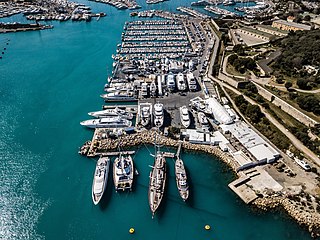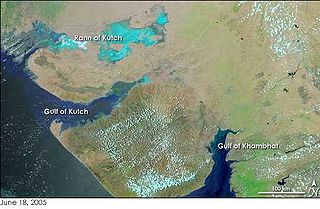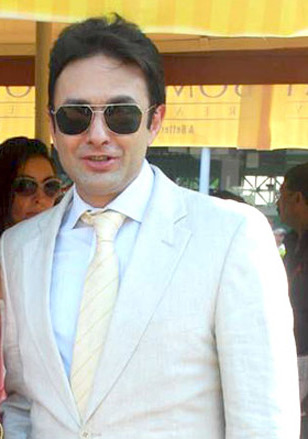
A shipyard, also called a dockyard or boatyard, is a place where ships are built and repaired. These can be yachts, military vessels, cruise liners or other cargo or passenger ships. Compared to shipyards, which are sometimes more involved with original construction, dockyards are sometimes more linked with maintenance and basing activities. The terms are routinely used interchangeably, in part because the evolution of dockyards and shipyards has often caused them to change or merge roles.

The history of Mumbai can be traced back to 600 BC, with evidence of the first known settlement of the Harrappan civilization discovered in the region.

Indian maritime history begins during the 3rd millennium BCE when inhabitants of the Indus Valley initiated maritime trading contact with Mesopotamia. India's long coastline which occurred due to the protrusion of India's Deccan Plteau helped it to make new trade relations with the Europeans, especially the Greeks, and the length of its coastline on the Indian Ocean is partly a reason why it's known as that since 1515, and was known as the Eastern Ocean earlier. The ocean was called so, due to the advent of international trade by the Europeans which still continues to this day. As per Vedic records, Indian traders and merchants traded with the far east and Arabia. During the Maurya Empire, there was a definite "naval department" to supervise the ships and trade. At the end of 1st century BCE Indian products reached the Romans during the rule of Augustus, and the Roman historian Strabo mentions an increase in Roman trade with India following the Roman annexation of Egypt. As trade between India and the Greco-Roman world increased, spices became the main import from India to the Western world, bypassing silk and other commodities. Indians were present in Alexandria while Christian and Jewish settlers from Rome continued to live in India long after the fall of the Roman Empire, which resulted in Rome's loss of the Red Sea ports, previously used to secure trade with India by the Greco-Roman world since the Ptolemaic dynasty. The Indian commercial connection with Southeast Asia proved vital to the merchants of Arabia and Persia during the 7th–8th century. A study published in 2013 found that some 11 percent of Australian Aboriginal DNA is of Indian origin and suggests these immigrants arrived about 4,000 years ago, possibly at the same time dingoes first arrived in Australia.
The Wadia family is a Parsi family from Surat, India currently based in Mumbai, India. The family rose to wealth in the mid-1700s as shipbuilders serving the British East India Company as the latter established its sway over India. During the declining years of the British Raj, Neville Wadia, scion of the main branch of the family, married Dina Jinnah, only child of Muhammad Ali Jinnah, the founder of Pakistan. Despite being the only descendants of the founding father of Pakistan, the family chose to stick to their mills and factories in India rather than emigrate to the new country. They prospered abundantly under Nehru-Gandhi dispensation and today, they run the Wadia Group of companies, one of the larger industrial conglomerates in India.

Britannia Industries Limited is an Indian multinational food products company, which sells biscuits, breads and dairy products. Founded in 1892, it is one of India's oldest existing companies and currently part of the Wadia Group headed by Nusli Wadia. As of 2023, about 80% of its revenues came from biscuit products.
Bombay Dyeing & Manufacturing Company Limited is an Indian textile company headquartered in Mumbai, India. It operates as a subsidiary of the Wadia Group and is one of India's largest producers of textiles.
Lovji Nusserwanjee Wadia (1702–1774) was a Parsi from Surat province of Gujarat in India and was a member of the Wadia family of shipwrights and naval architects, who founded Wadia Group in 1736.

The Bombay Burmah Trading Corporation Limited (BBTC) is an Indian trading company based in Mumbai owned by the Wadia Group. It was formed in 1863 by the Wallace Brothers of Scotland. It is India's oldest publicly traded company, and was established to engage in the Burmese tea business through the initial step of taking over the Burmese assets of William Wallace.

Bombay Dockyard, also known as Naval Dockyard, is an Indian shipbuilding yard at Mumbai. The superintendent of the dockyard is a Naval Officer of the rank Rear Admiral, known as the Admiral Superintendent.

Ness Nusli Wadia is an Indian businessman. Wadia is the managing director of Bombay Burmah Trading Corporation, a company which has holdings in most of the Wadia Group subsidiaries, including an indirect majority stake in Britannia Industries. He was the Joint Managing Director of Bombay Dyeing, the flagship company of the Wadia Group, till March 2011 when he stepped down from the post. Wadia is a co-owner of the Indian Premier League cricket team Punjab Kings.
Jehangir Nusli Wadia, also known as Jeh Wadia, is an Indian businessman, who was the Managing Director of Go First, Bombay Dyeing and Bombay Realty. He was also a Director on the Boards of Britannia Industries, The Bombay Burmah Trading Corp. Ltd, Wadia Techno – Engineering Services Limited & others.

Homi Wadia was an Indian film director and producer in Bollywood. He was the co-founder of Wadia Movietone productions, established in 1933 and later after the closure of Wadiatone, he founded Basant Pictures in 1942. In a career spanning five decades, he directed over 40 films, including Hunterwali (1935), Miss Frontier Mail (1936), Diamond Queen (1940), Shri Ram Bhakta Hanuman (1948) and fantasy film Hatim Tai (1956). He was also a founding member of the Film & Television Producers Guild of India, established in 1954. Homi Wadia was married to actress and stunt woman Fearless Nadia. Homi was the younger brother of JBH Wadia, who was himself a movie director.

Wadia Movietone was a noted Indian film production company and studio based in Mumbai, established in 1933 by Wadia brothers J. B. H. Wadia and Homi Wadia. It was most known for stunt, fantasy and mythological films, including Hunterwali (1935).
For the British expedition to the Red Sea (1801) the British government hired a number of transport vessels. The transports supported Major-General Sir David Baird's expedition in 1801 to the Red Sea. Baird was in command of the Indian army that was going to Egypt to help General Ralph Abercromby expel the French there. Baird landed at Kosseir, on the Egyptian side of the Red Sea. He then led his troops army across the desert to Kena on the Nile, and then to Cairo. He arrived in time for the battle of Alexandria. Captain Hardie of Shah Kaikusroo was appointed Commodore of the fleet of country ships.
Shah Ardaseer was built at Bombay, probably in 1786. English transliterations of her name show her as Shah or Shaw + Adaseer, or Ardaseer, or Ardasier, or Adasier, or Ardasheer, or Ardeseer, or Ardesir. A fire on 13 September 1809 at Bombay burnt her. She then may have been recovered, repaired, and enlarged to become the hulk HMS Arrogant, which was moved to Trincomalee in 1822 and sold there in 1842.

Bombay Dockyard or formally His Majesty's Indian Dockyard, Bombay was originally a naval facility developed by the East India Company beginning in 1670. It was formally established as a Royal Navy Dockyard in 1811 and base of the East Indies Station when the Department of Admiralty in London took over it. The yard was initially managed by the Navy Board through its Resident Commissioner, Bombay until 1832 when administration of the yard was taken over by the Board of Admiralty.
The Wallace brothers were the six sons of Edinburgh architect Lewis Wallace. In varying combinations, the brothers established themselves as one of the leading nineteenth century East India merchants, trading in cotton, tea, coffee and other commodities. Through their investments in Burma, they became the world's leading exporter of teak. The rise of independent governments after World War II meant the progressive loss of the family's Eastern assets and the redeployment of capital back to London. This capital was used in the 1960s to establish Wallace Brothers as a banking house but this strategy did not long survive the secondary banking crisis of 1973-75.












